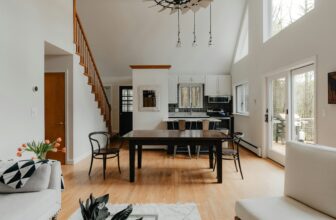
Choosing the Right Decorative Lighting for Small Spaces

Turn your small space into a well-lit sanctuary with these tips.
The right decorative lighting options can create an illusion of space in small rooms while making them welcoming. New research indicates that proper lighting design has powerful effects on both how well compact spaces function and how large they appear to occupants.
Your Complete Guide Inside:
- Understanding Small Space Lighting Challenges
- Essential Lighting Layers for Compact Spaces
- Smart Solutions for Different Room Types
- Latest Trends in Space-Saving Fixtures
- Installation and Placement Tips
Understanding Small Space Lighting Challenges
Compact living areas demand special attention to lighting because they present distinct challenges that must be carefully addressed. In compact spaces every lighting decision requires careful consideration because it affects both functionality and aesthetics. The increased emphasis on human-centric lighting demonstrates its vital role in enhancing well-being through proper illumination which becomes particularly crucial for maintaining ambiance in limited spaces.
Current design trends focus on sustainable solutions and energy-saving LED technology which show exceptional benefits in small spaces. Modern lighting solutions offer both energy savings and improved flexibility with placement and control options.
Essential Lighting Layers for Compact Spaces
Creating the perfect lighting scheme for small spaces involves understanding the three fundamental layers of lighting: Achieving an ideal lighting design for small spaces requires knowledge of the three core lighting categories which include ambient lighting together with task lighting and accent lighting. Every lighting layer fulfills a distinct role that when united with care can completely redefine your space.
Ambient Lighting: Your Foundation
The foundational lighting layer throughout your room comes from ambient illumination. When selecting fixtures for compact areas you must choose lighting solutions that deliver enough illumination while avoiding excessive brightness for the space. Consider these options:
Select flush-mount ceiling lights that maximize visual space without dominating the room Wall-mounted sconces create open floor space by eliminating the need for surface-mounted fixtures.
- Recessed lighting for a clean, uncluttered look
Task Lighting: Functionality First
Task lighting illuminates designated zones where tasks such as reading, cooking, or working take place. Small spaces require multifunctional task lighting solutions to maximize functionality and efficiency. Options include:
Desk lamps with pivoting features allow users to direct light to different areas as needed
- Under-cabinet lighting for kitchen workspaces
- Clip-on lights that don’t require permanent installation
Accent Lighting: Adding Depth
Accent lighting adds visual interest to spaces while making them appear bigger through targeted illumination of particular features. Consider using:
- Picture lights to highlight artwork
- Place LED strips behind furniture to produce a gentle ambient glow. Compact spotlights serve to highlight both plants and decorative pieces.
Smart Solutions for Different Room Types
All rooms in your home fulfill specific functions which should be reflected in your lighting selections. Smart lighting systems with app and voice control functionality have transformed our ability to adjust lighting to meet specific requirements while particularly benefiting smaller spaces.
Small Living Rooms
The living room combines entertainment spaces with relaxation zones. The key is versatility:
Choose dimmable LED fixtures for easy light level adjustments during daytime hours Wall sconces installation helps preserve valuable table and floor space.

Choose track lighting that allows you to direct light toward different sections as needed. Choose a statement pendant light that serves as an eye-catching focal point while conserving valuable floor space.
Compact Kitchens
A kitchen’s lighting system must deliver practical performance while creating visual appeal. Modern biophilic design trends demonstrate that natural light patterns improve the visual and practical appeal of compact kitchen areas. Modern solutions include:
- Under-cabinet LED strips for shadow-free workspaces
- These pendant lights offer pinpoint illumination while avoiding space congestion.
- Motion-sensor lights for pantry areas
- Slim-profile track lighting for adjustable task lighting
Small Bedrooms
Bedroom lighting systems need to be adjustable so they can shift from bright and stimulating to gentle and soothing atmospheres. The increased popularity of smart lighting integration supplies small bedroom spaces with adaptable lighting options that provide convenience. Consider:
Wall-mounted reading lights provide lighting solutions while removing the necessity of bedside tables.
- Dimmable ceiling fixtures for adjustable ambiance
- Install LED strip lighting behind headboards to create a gentle and diffused light effect. Compact pendant lights positioned at bedside hang directly from the ceiling.
Latest Trends in Space-Saving Fixtures
The lighting industry developed innovative designs and technologies in response to the increasing need for small-space solutions. Current lighting trends focus on sustainable and multifunctional solutions that improve both space usage and efficiency.
Minimalist and Multifunctional Designs
Revolutionary changes in small space illumination emerged from the growing trend of minimalist and multifunctional lighting design. Modern fixtures often serve multiple purposes:
Lighting solutions that combine shelving and illumination features Adjustable arm sconces which offer functionality as both working area lights and environmental illumination. Modular lighting systems allow users to adjust configurations according to their changing needs.
- Space-saving corner lamps that utilize often-overlooked areas
Smart Technology Integration
Smart lighting systems have advanced in complexity but continue to provide an easy user experience. These systems offer remarkable flexibility for small spaces:
Lighting systems activated by voice commands make physical switches unnecessary. Lighting systems which users can control through an app to change color temperature according to the time of day
- Motion sensors that automatically illuminate high-traffic areas
- Programmable scenes for different activities and moods
Sustainable and Energy-Efficient Solutions
With the growing focus on sustainability, energy-efficient lighting solutions have become both more advanced and more aesthetically pleasing:
LED fixtures deliver superior illumination while using minimal energy consumption.
- Solar-powered options for areas near windows
- Motion-activated systems that reduce unnecessary energy use
- Long-lasting bulbs that require less frequent replacement
Natural and Organic Materials
The use of natural materials in lighting fixtures has gained significant popularity, particularly in small spaces where every element contributes to the overall aesthetic:
Rattan and bamboo fixtures contribute texture to spaces without adding extra bulk. Paper globe lights emit gentle diffused lighting for a cozy atmosphere. Wooden features provide a cozy touch to modern interior designs. Shades made from natural fibers produce dynamic and distinctive lighting patterns.
Installation and Placement Tips
Your small space lighting design will only work properly when you install fixtures correctly and place them strategically. These key considerations will help you achieve optimal lighting performance in your area.
Height and Positioning Guidelines
Proper fixture placement is crucial in small spaces where every inch counts:
Install pendant lights between 30 to 36 inches above tabletops or kitchen counters Install wall sconces at eye level which measures 65-70 inches above your floor level Install bathroom vanity lights 75-80 inches above the floor for proper illumination. All ceiling fixtures in walkways require a minimum clearance distance of 7 feet.
Maximizing Natural Light
Before adding artificial lighting, optimize your natural light sources:
Strategically place mirrors to enhance and spread natural light throughout a room. Select window treatments that are light in color to allow light filtering without complete obstruction.
- Keep windows clean and unobstructed where possible
- Installation of glass doors or transoms between rooms will help maintain the flow of light.
Safety Considerations
When installing lighting in small spaces, safety should be a top priority:
Verify that all electrical installations comply with local building code regulations.
- Use appropriate wattage bulbs for each fixture
- Install proper ventilation around recessed lights
- Keep heat-generating fixtures away from flammable materials
Common Mistakes to Avoid
Certain pitfalls in lighting small spaces can cause your area to feel cramped and functionally diminished. Here are key mistakes to avoid:
Overlooking Scale and Proportion
One of the most common errors in small space lighting is choosing fixtures that are either too large or too small:
- Oversized chandeliers that overwhelm the room
- Small fixtures that don’t deliver sufficient illumination The improper spacing of recessed lighting systems generates distracting shadows. Wall sconces that extend too far into walkways present a common mistake in small space lighting.
Poor Light Distribution
Uneven lighting can make small spaces feel cramped and uncomfortable:
Overhead lighting alone produces intense shadows in the space.
- Insufficient task lighting in work areas
- Accent lighting draws too much attention without the balance of ambient lighting. Failing to illuminate dark corners can make the space feel smaller.
Ignoring Color Temperature
The color temperature of your lighting plays a crucial role in how spacious a room feels:
- Using cool white lights in relaxation areas
- Mixing different color temperatures without purpose
- Failing to account for natural light variations
- Failing to understand the impact of light colors on room colors
Expert Design Tips and Tricks
Design experts have established various reliable lighting techniques to optimize small spaces. Here are some of their top recommendations:
Create Visual Interest
Add depth and dimension to your space without taking up valuable square footage:
By utilizing uplighting you can make ceilings look taller and direct attention upwards. Establish depth in your lighting scheme by positioning fixtures at various heights. Functional lighting installations function as artistic light pieces. Textured light fixtures create visual appeal in your space.
Flexible Solutions
Integrate adaptable lighting solutions that can change with your needs:
- Install dimmer switches for variable light levels
- Use adjustable track lighting for versatile illumination
- Select lighting options that allow for simple relocation.
- Select fixtures with adjustable arms or heads
Ready to Illuminate Your Space?
Lighting small spaces requires no special difficulties. Implement these guidelines and steer clear of common mistakes to establish an inviting space that appears more spacious and functional through proper lighting. Remember to:
- Consider all three layers of lighting: ambient, task, and accent
- Select light fixtures that match both your space’s dimensions and its purpose.
- Take advantage of natural light whenever possible
- Incorporate smart technology for added convenience
- Focus on energy efficiency and sustainability
- Prioritize proper installation and safety

Appropriate lighting solutions can transform small spaces into bright areas that appear more expansive. Begin your lighting project by focusing on one room at a time and be willing to test various lighting setups to determine the optimal arrangement for your area.




